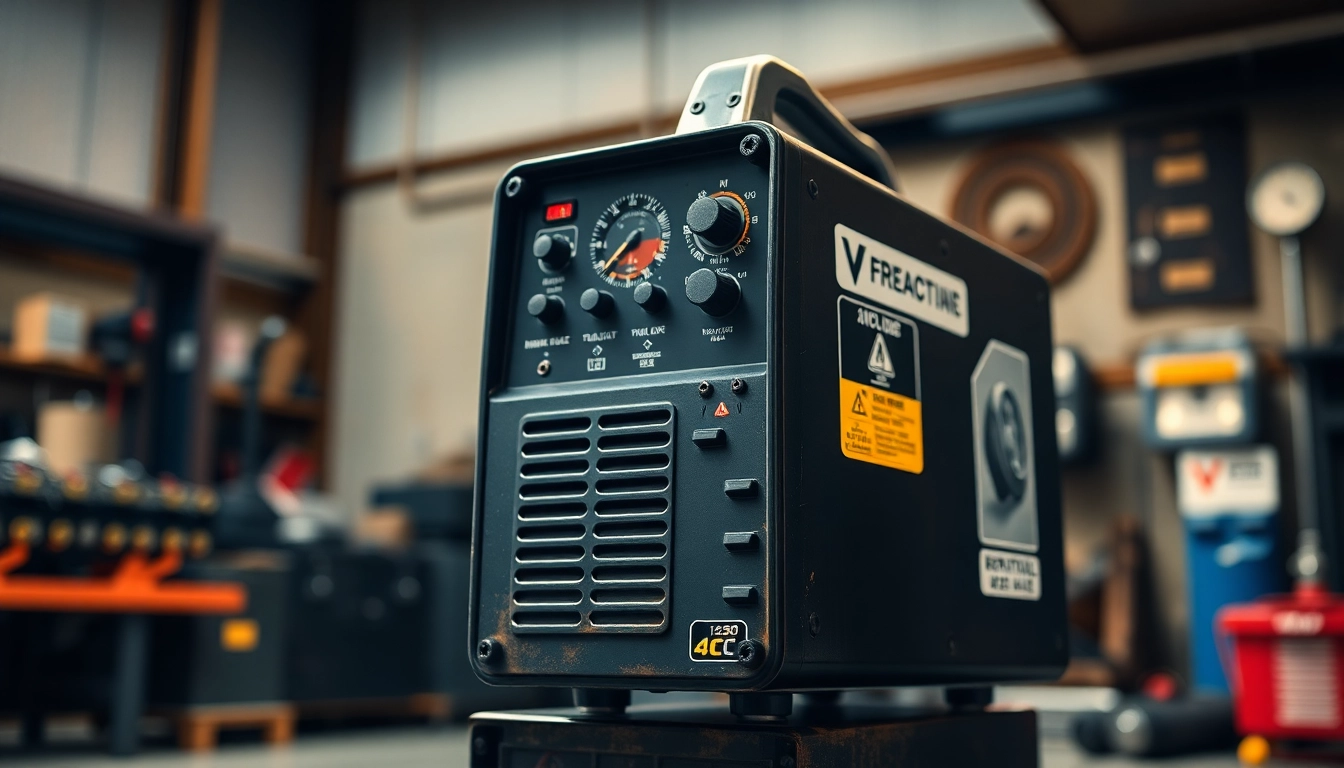Understanding AC DC TIG Welders
What is an AC DC TIG Welder?
An AC DC TIG welder is a welding machine that can switch between alternating current (AC) and direct current (DC). This dual capability allows the user to perform a wider range of welding tasks with metal materials, offering flexibility essential in many industries. AC is typically used for welding non-ferrous metals like aluminum and magnesium, while DC offers greater control for ferrous metals and provides a steadier arc and higher penetration. Understanding the functionalities of these welders can significantly improve your welding precision and quality.
Benefits of Using AC DC Technology
The transition between AC and DC modes in TIG welding machines comes with multiple advantages:
- Versatility: The ability to switch between AC and DC allows the welder to tackle different materials and thicknesses. This flexibility is particularly beneficial for users who work with various metals.
- Improved Arc Stability: DC welding produces a smoother arc, allowing for cleaner welds especially on thinner materials. AC maintains a more consistent heat for aluminum welding, stabilizing the molten pool.
- Enhanced Cleaning Action: The AC process generates a cleaning effect that removes oxidation from the surface of aluminum, ensuring better adhesion of the weld.
- Control Over Heat Input: Welders can adjust the output settings based on their specific needs, enabling precise control over material penetration and heat input, which is crucial for avoiding warpage and burnout in sensitive projects.
Common Applications of AC DC TIG Welding
AC DC TIG welders are commonly utilized in various applications, including:
- Aerospace: Precision welding is essential in the aerospace industry for constructing aircraft components using lightweight materials.
- Automotive: Fabricating and repairing automotive parts, especially aluminum and stainless steel components.
- Fabrication Shops: Commonly used for precise metalworking processes, significantly benefiting from the versatility of AC/DC functions.
- Artistic Metalwork: Sculptors and artists often use TIG welders to create intricate designs in metal art.
- Marine Applications: Ideal for welding aluminum boat hulls and other marine components due to its strong capability with non-ferrous materials.
Choosing the Right AC DC TIG Welder for Your Needs
Key Features to Consider
When selecting an AC DC TIG welder, several features should be prioritized:
- Amperage Range: The welder should offer a sufficient amperage range to accommodate various thicknesses. Typically, a range of 20 to 250 amps is suitable for most applications.
- Duty Cycle: This refers to the welder’s ability to operate continuously for a specific duration. Higher duty cycles mean less downtime and better overall efficiency.
- Portability: Evaluate whether you require a portable machine for on-site work or if a more stationary powerhouse is sufficient for your workshop.
- Control Features: Look for models equipped with adjustable settings for gas flow, arc length, and foot pedals for added control over the welding process.
- Weld Quality: Ensure the welder produces high-quality outputs with minimal spatter and clean finishes.
Comparing Entry-Level vs. Advanced Models
Entry-level AC DC TIG welders are typically more affordable, user-friendly, and ideal for beginners or those with light-duty needs. These models usually lack some advanced features but perform well for basic welding tasks. Conversely, advanced welders offer extensive features, including programmable settings, higher amps, and often come with more robust components that enhance productivity in industrial applications.
Choosing between these models often comes down to your specific welding tasks:
- Entry-Level: Suitable for hobbyists and DIY projects. Look for brands known for reliability and customer service.
- Advanced Models: Designed for professional use, catering to industries that demand high-quality welding. These machines often have more powerful output and additional features for performance improvements.
Best Brands in the AC DC TIG Welder Market
Several brands are well-established in the AC DC TIG welder market, recognizable for quality and performance:
- Miller Electric: Known for durable construction and excellent customer support, Miller offers a variety of models catering to both professionals and hobbyists.
- Lewis: Offers versatile machines, covering a wide range of tasks from light welding to heavy industrial work.
- Eastwood: Affordable options suitable for beginners, providing necessary features without the hefty price tag.
- Lincoln Electric: Features high-performing models that are industry slaves with advanced technology capable of handling various applications.
- Everlast: Offers competitive pricing with robust features designed to meet diverse welding needs.
How to Set Up Your AC DC TIG Welder
Essential Tools and Accessories
To effectively set up your AC DC TIG welder, you will need several tools and accessories:
- Tungsten Electrodes: Choose the right type (pure tungsten, thoriated, lanthanated) based on the material you’re welding.
- Filler Rods: Select appropriate filler rods depending on the metals you intend to weld.
- Protective Gear: Includes gloves, helmets with appropriate shading, and protective clothing to shield from sparks and UV radiation.
- Gas Supply: Argon is typically used for shielding gas; ensure a proper regulator and gas flow meter is available.
- Cooling System: If your machine requires water-cooling, set up a circulation system to prevent overheating during operation.
Safety Precautions and Best Practices
Safety is paramount when working with TIG welders, and adherence to certain practices can minimize risks:
- Wear Protective Equipment: Always wear welding gloves, goggles, and protective clothing.
- Work in a Ventilated Area: Ensure sufficient ventilation to avoid inhaling fumes and maintain air quality.
- Inspect Equipment: Regularly check the welder, cables, and connections for wear and any potential faults before usage.
- Clear Surroundings: Ensure your workspace is free of flammable materials and debris to prevent accidental fires or injuries.
Step-by-Step Setup Instructions
Setting up your AC DC TIG welder involves a series of steps to ensure optimal performance:
- Gather Tools and Equipment: Ensure you have all necessary tools, electrodes, and safety gear ready.
- Choose Appropriate Settings: Select AC or DC mode based on the material and set the amperage.
- Connect Gas Supply: Attach the Argon tank and set the regulator to the desired flow rate, which usually falls between 10-15 cubic feet per hour.
- Install Tungsten Electrode: Insert the tungsten electrode into the collet and tighten it securely.
- Attach Ground Clamp: Connect the ground clamp to your workpiece to ensure a good ground connection.
- Test the Setup: Conduct a test weld on scrap material to ensure settings are correct and make adjustments as necessary.
Tips to Improve Your AC DC TIG Welding Skills
Common Mistakes and How to Avoid Them
Taking time to understand and rectify common errors can significantly enhance welding quality:
- Inconsistent Arc Length: Maintain a steady arc length, ideal for TIG welding should be about the distance of the electrode diameter.
- Incorrect Travel Speed: Practice maintaining a consistent travel speed to avoid undercutting or excessive heat.
- Poor Preparation: Properly clean and prepare surfaces for welding to enhance adhesion.
- Incorrect Voltage Settings: Regularly adjust voltage settings according to the material thickness to achieve better penetration and appearance.
Techniques for Enhanced Weld Quality
To improve the overall quality of your welds, consider implementing the following techniques:
- Use the Right Electrode: Different metals require specific electrode compositions; match them accordingly to enhance performance.
- Maintain a Steady Hand: Develop a steady hand to keep the torch motion consistent and avoid disruptions in the arc stability.
- Watch the Heat: Monitor the heat and adjust the distance of your nozzle to prevent warping.
- Practice on Scrap Material: Frequent practice will help refine techniques and adaptability to unexpected challenges.
Resources for Learning TIG Welding
For those looking to hone their skills, various resources are available:
- Online Tutorials and Courses: Platforms like YouTube feature numerous tutorials from skilled welders.
- Books and Manuals: There are many respected books in welding that offer both theoretical and practical insights.
- Community and Forums: Engaging with communities, such as Reddit’s welding forum, allows sharing of tips and experiences.
- Local Workshops: Enroll in community college welding courses for hands-on learning from professionals.
Maintaining Your AC DC TIG Welder
Routine Maintenance Tips
Regular maintenance can extend the lifespan of your AC DC TIG welder:
- Clean the Torch: Regularly clean the torch to prevent buildup of contaminants which may affect performance.
- Inspect Cables and Connections: Ensure cables are intact and connections are secure to avoid electrical issues.
- Check Cooling System: If applicable, ensure the cooling system is functioning correctly to maintain the welder’s temperature.
- Maintain Ground Clamp: Regularly check the ground clamp for integrity and ensure it is clean and free of oxidation.
Identifying and Troubleshooting Common Issues
Being aware of potential problems and their solutions can save significant downtime:
- Inconsistent Arc: Possible causes include a faulty electrode, wrong gas flow rate, or incorrect settings. Check and adjust as necessary.
- Overheating: Overheating may be due to inadequate airflow or high duty cycles; check cooling systems and reduce operational load.
- Inadequate Penetration: Symptoms of insufficient penetration may be solved by adjusting your travel speed or increasing the amperage.
- Arc Not Starting: This could be stemmed from issues in the gas flow or electrode integrity. Check both before initiating the arc.
When to Seek Professional Repair Services
While routine maintenance can often resolve common issues, there are instances when professional help is necessary:
- Electrical Failure: Seeking professional assistance is advisable if you experience persistently unreliable electrical issues.
- Internal Damage: If there is potential for internal damage (e.g., transistors or diodes), a qualified technician should assess it.
- Multifactorial Problems: When multiple symptoms arise at once and troubleshooting doesn’t clarify the issue, consulting professionals can help diagnose and ensure equipment safety.



